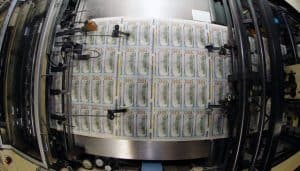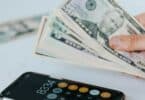Money is the quintessential means of payment in the developed world. However, not everyone really understands the meaning of it, as well as who is in charge of creating it or how it creates itself.
We have all once seen on television the printing press that manufactures SAR, Dollar, eurozone banknotes, etc. but is there anything else behind this process? Have you ever wondered how the paper money you carry in your pocket is made?
Money is produced in special factories, which are the only ones in a given country that have the right to do so. These are places equipped with specialized equipment and closely guarded to prevent counterfeiting.
Banknote printers produce their own paper, which is very durable. This is important because the banknotes will change hands, they will crumble in wallets and pockets, so they must be extremely strong and resistant to damage. You may be surprised, but they are made of a similar material as your shirt!
One of the security features is a watermark. It’s such a magic trick that only a real banknote can do. If you hold it against the light, you will see a pale image, and when you put it on a table, for example, it will disappear immediately.
Another protection is a plastic or metal thread that is woven into the banknote – when you look against the light, you’ll definitely see it.
There are still protections that you won’t even see against the light; you can see them only on special devices. In addition, each banknote has a unique serial number.
The Money Making Process
Do you know what the processes are until each note reaches your hands?
As soon as the paper reaches the mint, it is necessary to go through a series of strict established parameters by central banks. They are rulers that check every thousandth of a millimeter of the dimensions of the paper. Electronic scales measure the weight of each sheet. Microscopes check each fibre inside the paper structure.
Not enough, there are still machines that measure the pore size of the paper, roughness, brightness, and opacity. There is even a test that verifies the degree of difficulty in removing the fibres from the surface of the samples. This particular test serves to predict what could happen, for example, if a tape was stuck and then pulled out of a future note. The acidity of the paper is one of the factors analyzed; this is because if the acidity value is not accurate, it can impair the drying of the ink that will be printed.
Another test is done on the “double fold” machine, which folds and unfolds and folds the paper samples a few thousand times. These are just some examples of the entire process that is followed in detail, from the first paper shipment, analyzed through more than 30 types of laboratory tests.
There are only four companies in the world that supply the essential raw material for making money, paper. One of them, Papel Salto, is located in Brazil, in the interior of São Paulo. Even before it becomes money, this role is closely monitored.
Each sheet is created only to order, according to the secret specifications of each buyer. Once ready, each sheet is numbered and counted.
1.The Paper of The Money
The paper created for making banknotes consists of three overlapping layers. The outer layers are usually made of wood paste. The middle blade is 100% cotton.
Línter, this is the name of the shortest cotton fibre, obtained in the last cut of the seed [which enters the cutting machine three times, resulting in increasingly smaller fibres; the linter is close to the core, so it only comes out on the third cut] is the main ingredient in the middle layer of the note.
The middle layer receives the main security measures, which make counterfeiting difficult.
2.Safety
The filigree is any figure, chosen by the government, and the first protective measure. The image is engraved in high relief, using a mould that compresses the moist cotton paste, still in the manufacturing process.
Filigree, also known as “watermark”, is the effigy [representation of a person in a coin, painting, or sculpture] of the Republic. This layer is protected by the outer blades, so the watermark is only seen when viewed against the light.
The banknotes are so safe that no one has ever been able to copy them, just the rare exceptions made by foreign governments.
In addition, the notes also have small rayon fibres, a synthetic thread, placed between the cotton layer and the outer ones. This composition also includes a magnetized polyester thread. The wire has the colors green, red and blue, and can only be seen when placed against the light.
3.Coloring
There are 17 colors in all. The first ten are applied to most of the notes. They give colors to the background, designed by the computer. Another six paints are especially for noble places and applied through chalcography [engraving process done in a metal matrix, usually copper. It can also be made in aluminum, steel, iron, or yellow brass].
The formula of these paints is one of the best-kept secrets in the world. Of course, the paints are also special, thick as toothpaste, create colors in three dimensions. They get higher or lower in different parts of the notes. So it is possible to feel the painting with your fingers.
The 17th ink used in printing is a mixture of iron oxide. Because it is magnetized, this substance can be identified by a device known commercially as “test dollar”. Before being printed, the inks are subjected to 18 laboratory tests. In order to verify its resistance.
Where is money made?
Banknotes are printed differently than on a regular printer. For a well-secured banknote to come out, the printing house uses a lot of different methods that only together give the end result you see. Even the colors are very difficult to counterfeit because they arise from mixing many inks together. Everything is done so that no one prints the money on their own but earns it like others.
As for coins, they are made in a special place called the mint. Initially, coins were hand-made from gold or silver. Now they are made of cheaper metals because the value of coins is not very high. Again, special machines come into operation, which cut out the rings, and the mint stamp with great force punches the appropriate pattern on them.
1.Issuing banks
The currency of each country or territory is created and issued by its central bank.
In other words, Banknotes and coins are issued by the competent monetary authority, which is generally the central bank of each country.
In Europe, for instance, we have the Euro which is issued by the European Central Bank.
Therefore, most people believe that central banks alone are responsible for creating money. However, this is not the case: private banks are also capable of creating money, to the point that in practice, 95% of the money is created by private banks.
The issuing (central) bank manages monetary policy, especially through the determination of money interest rates and the reserve requirement, as we will see in the next point.
However, we cannot say that it is the central banks that create the money: it is true that they deal with the issuance of notes and coins, but this money in the form of notes and coins is only 5% of the money in circulation. They also make injections or withdrawals of liquidity through purchases or sales of financial assets in primary and secondary markets and loan money to commercial banks, but this is only a very small part of the money in circulation.
Its fundamental intervention is what has been said at the beginning: the determination of the applicable interest rates, the cash ratio, and the regulation of the private banking sector.
2.The banks
It is the commercial banks that create the money in circulation.
When we talk about banks, we refer to all financial entities: commercial, industrial and savings banks, both public and private.
As said at the beginning and as explained below, 95% of the money there is is created by these banks.
The money that the central bank lends to private banks is to them and among them where it circulates, but it does not go to individuals who are clients of those banks, these clients receive loans and manage their money in bank accounts.
Before this happened to a great extent, fifty years ago the cash ratio was around 15% or 20%, nowadays with electronic transactions and payments it happens overwhelmingly, the cash ratio is around 1%.
A commercial bank performs three types of operations:
- Asset operations: which consist of granting credit to your clients in the form of loans, credits or discounts.
- Liability operations: which consists of collecting and saving money from its clients in the form of deposits of all kinds.
- Banking services: payments, collections, transfers, financial services such as purchase and custody of securities, etc.
Money printing/production process
How money is printed is one of the many myths about money. Perhaps this occurs because as we almost always have it there, or it reaches us, we do not stop to ask ourselves where it comes from. Or what is the process that has to be executed so that it reaches our hands?
Producing a new banknote is a real challenge. There are a lot of people involved in this process, especially experts with unique knowledge and skills. Why? Because the banknotes represent one’s country, they must be secure and protected against counterfeiting, they should be durable, and should also be liked.
Who Prints Money?
Knowing how money-making works in the world, but especially in your country, seems a distant matter.
To know who prints the money in each country, you have to look closely at its regulation. Because this process does not occur in all nations in the same way. For instance, in the United States, the Federal Reserve (FED) is responsible for this process.
This entity determines how many new notes and coins can be produced in the country.
In fact, this is in the hands of the BEP (US Bureau of Engraving and Printing) or Office of Engraving and Printing. It has offices in Washington and Texas, operates 24 hours a day. And it’s one of the people in charge of having money circulating in the streets.
A brief description of the production process
1.Offset printing process
In this process, the multicolored images that make up the background of the banknote are printed on white security paper. Background printing is an indirect printing in which the plate receives the ink and transmits it to the blanket, which is responsible for transmitting the image to the security paper.
This printing is carried out simultaneously on both sides of the sheet, thus obtaining security elements such as the perfect register, iridescent and anti-scanner devices, among others. Additionally, images of the design are printed in fluorescent or phosphorescent ink (invisible image), only observable with ultraviolet light.
2. Intaglio printing process
Intaglio printing is a process by which high-relief printing is carried out on an image previously printed in offset. During this process, the main texts, the numbers that identify the denomination, and the complementary images such as the bullets (drawings that are generally placed on the upper or lower edge of the banknote) as well as the main motif (character portrait) are printed.
3.Automatic review process of printed sheets
It is a process prior to printing the serial number of the ticket. This inspection is carried out with a module installed in the automatic numbering machine. The review is carried out, with high-resolution cameras, on the front and back and at 100% of the sheet, including transparency. This process originates part of the statistical information that can be used to improve production processes.
4.Manual review process of printed sheets
In this quality control process, inspection is carried out, on both sides, of all the sheets printed in the previous processes. From this review, the statistical data are obtained with which the necessary actions are taken to increase the quality levels in the printing processes.
5.Letterpress printing process
Numbering printing is a direct process using movable, cast, and high relief engravings, which work automatically in sequential order, printing the numbering on each banknote. For some denominations, the parts of the design are printed in fluorescent or phosphorescent ink (invisible image, only observable with ultraviolet light).
6.Varnishing Process
The application of the varnish, which is done through a flexographic printing process, is done by applying a layer of varnish to the numbered security paper, both on the front and back, in order to protect the print and give it greater durability to the ticket.
7.Cutting, packing, and packaging process
The cutting and packaging is the final stage of the production process in which the final dimensions of the banknote are obtained, through two cutting stations, where the sheets are cut and grouped into 100 units. These groups are called bundles that are packed in plastics by the heat-sealing process. These are grouped into 10 bundles which are packed in plastic bags. These packages called bales are packed in boxes or containers according to the client’s requirement. Soon they will go to banks and ATMs across the country.
In a nutshell, the notes go through three stages to be printed.
- The bottom is printed in dry offset. But it is not quite a common process. Conventional offsets select areas of the paper where ink should not be applied. The dry offset has its embossed matrices, and the highlighted parts touch the paper. In addition, on this machine, printing is done on both sides simultaneously, which has the advantage that there is no mismatch between lines and shapes on one side and the other. This machine is called the Simultan.
- Then, the notes go to the Intagiocolor printer, which highlights the print. The ink is applied to the paper using a force equivalent to several tons. Making the ink in small grooves carved by hand in the matrix metal. These grooves provide the desired height for the paint layer.
- Super Numerota, the 3rd printer, is the one that records the serial number and the chancels of the Minister of Finance and the president of the Central Bank.
Once ready, the notes are reviewed, one by one, in the criticism section, where only women work. This is because it is believed that men are not keen to find small printing flaws by briefly glancing. Then the banknotes are cut and packed. But they are only effectively considered as money once they are on the streets, backed by the Central Bank’s backing.
What kind of paper is the money printed on?
The paper where the money is printed is very far from being a common paper, since it is not like most of the papers that are made with wood pulp but with cotton and linen, and although it is not actually carried out as part of a super-secret process or recipe, many details and security elements are incorporated into this manufacturing process, which gives the banknote properties of unrepeatable originality and makes its counterfeiting more laborious.
How is the paper money manufacturing process carried out?
Paper money is very similar to a piece of cloth; in fact, it is often called rag paper as a kind of distinction from paper made from wood pulp. Having been made with cotton and linen, in a ratio of 75% – 25%, respectively, it prevents this paper from being damaged like wood pulp paper when it is folded or wrinkled.
You can check it by squeezing or squeezing a normal paper inside the hand that it is usually wrinkled or folded and does not return to its original position unless you stretch it, while this paper intended to be a coin, in front of your eyes tends to stretch slowly to try to get to be in its original state. When made with fabric, this paper is more durable, more resistant, and less fickle.
However, not only cotton and linen are used to make the paper where the denominations of coins are printed, but other materials are also used that will give it a special and secure configuration. Although the United States Department of Treasury has not published it, everyone knows that in order to distinguish the paper it uses for its banknotes, it adds fine red and blue thread fibres to the process, which makes the process of counterfeit banknotes difficult.
In addition to these fine fibres, another secure element has been incorporated into the paper-making process where the money will be printed: a polyester strip embedded in the banknote. This security strip is a band that has a microprint along with the note, indicating its denomination. This band can only be seen against ultraviolet light, making it practically invisible to the naked eye.
The impression made on the paper also has its details, because when combined with the paper material, the ink produces a mixture of physical and chemical properties that make the difference with normal paper more latent. These effects produced by ink on paper are the elements on which merchants and bankers rely to use a counterfeit bill detector marker.
This marker has a felt tip impregnated with a special ink that, when traced on legal paper, the tracing is displayed in yellow or light brown, while if it is made on other paper, the tracing acquires a dark brown or black.
If the material of the paper and the ink were not enough to make a banknote original enough, there are other techniques that the current banknote manufacturers use. They use ink that gives a relief frame to the print on this rag paper, making the banknote tactilely different from plain paper.
In fact, this feature is very useful for blind people to recognize banknotes of different denominations. For example, In the US dollar, one of the raised lines is the inscription “United States of America” on both sides of the bill.
To achieve these reliefs, magnetic ink is used, and the paper is subjected to a pressure of 20 tons during a printing process of 8,000 sheets per hour. These sheets are then reviewed, both visually or manually, and through computerized scanners to try to detect irregularities, in case of detecting them, the irregular pieces are destroyed.
Those banknotes that pass the test are stacked in groups of 100 and then go to a cutter where these printed banknotes are separated.
What are the companies that manufacture banknotes in the world?
This banknote manufacturing process, for instance, is often used by the United States Bureau of Engraving and Printing to manufacture the dollars. However, there are other banknote manufacturers in the world that use a similar process, adding other features to paper to make the task of people counterfeiting banknotes more difficult.
One of these manufacturing companies is De La Rue, which manufactures the paper money that circulates in many countries around the world, including England and Kuwait.
The manufacturing process of these banknotes takes from six months to a year, and this is due to the increasing level of sophistication, both in terms of design and security, for now, the trend is not only to print faces of national heroes or flags on banknotes but also colorful animals or striking flowers, while on the other hand there is the objective of winning the war against counterfeiters who use high technology to make almost authentic banknotes.
See Also
How much money is there in the world?
How do Credit Cards Work?










